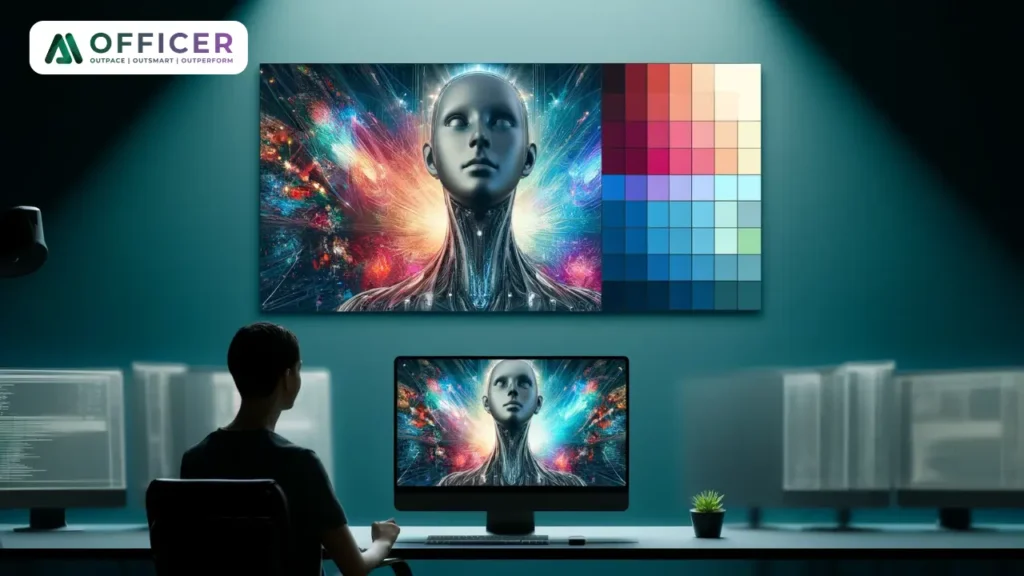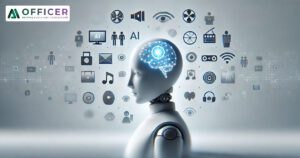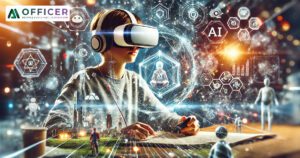
We’ve all been there. Scrolling through social media, bombarded by the same beach scene plastered with a different product each time.
Stock photos have become the beige walls of the digital world – familiar, reliable but ultimately uninspiring.
It’s time to break free from the stock photo rut thanks to the intriguing world of AI-powered image creation. It’s not about replacing human creativity; it’s about augmenting it, offering a tool to generate unique, eye-catching visuals that truly spark curiosity about your brand.
This week, AI Officer dives into the fascinating, yet uncharted territory of AI image generation.
We’ll explore the potential of this technology while acknowledging the challenges it presents. After all, knowledge is power and we want to empower you to decide if AI art deserves a spot in your marketing toolbox.
BEYOND THE BLAND : A SPARK OF INSPIRATION
Imagine conjuring a surreal desert landscape where cacti sprout hamburgers, or a playful octopus juggling your company logo. These aren’t fever dreams; they’re potential outputs from AI image generation tools like Ideogram and Midjourney.
These platforms embrace natural language instead of forcing you to navigate a labyrinth of keywords. Craving a product launch video set on Mars? You can describe the scene in detail and the AI might just paint that picture (or rather, pixelscape) for you.
The potential for democratizing creativity is undeniable. Just like the printing press revolutionized communication, AI image generation could level the playing field for entrepreneurs. Even resource-constrained startups can now craft visually arresting content that stands out from the crowd. Satya Nadella, CEO of Microsoft, recently echoed this sentiment, highlighting AI’s ability to “fundamentally change how we think, work and live”.
NAVIGATING THE ETHICAL MAZE
However, ethical considerations are paramount in the realm of AI-generated visuals.
A major concern is copyright infringement. Since AI systems train on massive datasets of existing images, the line between inspiration and imitation can be blurry.
Bias is another potential pitfall. If the training data perpetuates stereotypes, the AI may unintentionally generate images that reinforce those biases. As responsible businesses, we need to choose AI tools developed with ethical considerations in mind.
CRAFTING COMPELLING AI ART : A GUIDE FOR THE CURIOUS
So, how can you, as a forward-thinking entrepreneur, leverage the power of AI image generation while avoiding the pitfalls?
Here are a few pointers to get you started :
- Seek Out Ethical AI Providers : Research different platforms and understand their approaches to copyright and bias mitigation. Look for tools committed to responsible AI development.
- Embrace the Muse, Not the Mimic : Don’t expect the AI to churn out replicas of existing images. Use it as a springboard for original ideas. Think complementary, not derivative.
- Humanity – The Secret Ingredient : The AI should be a partner in creativity, not a replacement. Curate the generated images and select the ones that resonate most with your brand message.
We’ve explored the exciting world of AI image generation, but the innovation doesn’t stop there.
Here’s a sneak peek at some of the intriguing developments and potential future directions of this technology in 2024 and beyond :
- AI-Aided Photorealism : While some AI-generated images possess a dreamlike quality, the demand for photorealistic images remains high. Advancements in deep learning algorithms are blurring the lines between AI-generated and real-world photography.
Imagine creating product mockups so realistic they appear shot in a professional studio, all from the comfort of your home office. Tools like Midjourney are already pushing boundaries in this area.
- Text-to-Image Nuance : Current AI image generation tools are impressive, but they can still misinterpret descriptive prompts. The future lies in increased sophistication when translating written descriptions into visuals.
Imagine describing a “whimsical tea party hosted by hedgehogs wearing tutus” and having the AI consistently generate an image that perfectly captures that specific scene. This level of nuance is on the horizon.
- Style Transfer and Customization : One of the most exciting possibilities is AI-powered style transfer.
Imagine taking your photograph and applying the artistic style of Van Gogh or Picasso instantly. This technology could revolutionize personalized marketing materials and social media content. Platforms like Prisma are offering a glimpse into this future.
- 3D Image Generation : The ability to generate high-quality 3D images is another frontier in AI development. This would open doors for product design visualization, architectural renderings and even the creation of entirely virtual worlds. While 3D AI image generation is still in its nascent stages, the potential impact is significant.
Now, let’s discuss the risks and rewards of using AI for commercial image creation-
REWARDS
- Efficiency and Speed : AI can generate images much faster than human artists, which can be particularly beneficial in commercial settings where time is often critical.
- Cost Reduction : AI can help reduce costs associated with hiring human designers for routine or bulk image creation tasks.
- Innovation and Creativity : AI can generate unique visual concepts that might not be immediately apparent to human artists, potentially leading to more creative and innovative designs.
- Scalability : AI can easily scale up to handle large volumes of image production without the need for additional human resources.
RISKS
- Quality and Nuance : While AI has made significant strides, it may still struggle with the nuanced understanding of brand identity and emotional resonance that professional human artists grasp.
- Ethical Concerns : The use of AI in image creation involves concerns regarding originality, intellectual property rights and the potential reduction of jobs for human artists.
- Dependence on Data : AI systems are only as good as the data they are trained on. Poor or biased data can lead to unsatisfactory or offensive output.
- Lack of Emotional Connection : AI may not fully replicate the emotional depth and personal touch that human artists imbue in their work, which can be crucial for certain brands and messages.
These factors should be carefully considered when deciding whether to incorporate AI into your image creation process.
At AI Officer, we stay at the forefront of AI image generation advancements. We can help you navigate ethical considerations, choose the right tools for your needs, and integrate AI image creation into your marketing strategy.
Get in touch with our AI Officers today to discuss how AI image generation can transform your visual content creation and propel your brand forward.




